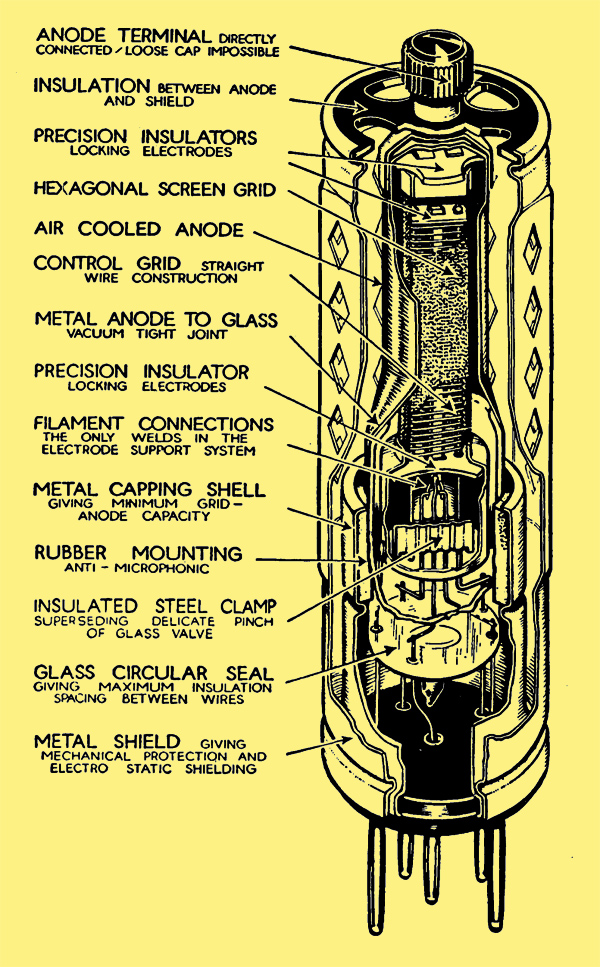|

The Catkin series can with hindsight be seen as one of MOV's amazing blind alleys. But, it took MOV about five years to learn how to make large glass power pentodes with grid structures which did not emit electrons, or buckle, due to overheating.
Keith Thrower in History of the British Radio Valve to 1940 states that Catkins were put into limited production at the MOV Hammersmith Plant in May 1932 but they had leakage problems and market release was delayed about a year. There was an announcement in Popular Wireless in May 1933 that is seen as the official launch of the first series of Catkin valves.
Valves like the MPT4 and MH4 were technically very superior to the glass versions. The compact catkin version was possible because the external anode was directly air cooled and did not reflect excessive heat back to the cathode-grid region of the valve. The purpose of the rubber seal was to clamp the glass firmly whilst allowing for thermal expansion without stressing the metal/glass seal. Microphony, the plague of the azide era, was never a problem with catkins.
The Series 2 catkins (1934) comprised the N30, the W30, the VMP4 and the B7 version of the MPT4.
Unlike the Series 1, which were catkin versions of types already available in glass envelopes, the second series were essentially new types, except the MPT4/K7 which was new only in the sense that all earlier MPT4s had been fitted with B5 base caps. The N30 was a version of the MPT4 with a 13V 0.3A heater, intended for use in AC/DC sets, the VMP4 was an much improved improved pentode successor to the VMS4, while the W30 was the 13V 0.3A version of the VMP4.
The types of valve selected for Series 2 catkin release are mutely eloquent. Whereas Series 1 comprised sufficient types to populate a complete radio (except for the rectifier), Series 2 did not. There was no frequency changer and no detector. The frequency changers and double-diode-triode detectors in demand for modern superhets could not be realised effectively within the constraints of catkin technology so glass versions had to be designed. Series 2 was the swansong of the catkin; by 1935 production had virtually ceased and glass versions (N30G, VMP4G, W30G) were being supplied instead.
Generally catkins were good, reliable valves but they were introduced during the early and mid 1930s by which time the modern superhet was already being designed in radio manufacturers' laboratories. It is perfectly possible to build a superhet of sorts using only catkin valves (at least one was put on the British market) but the cheap, efficient AC mains superhet, which led the market during the 1930s, 1940s and 1950s, is based on a triode-hexode frequency changer, a double-diode triode detector capable of generating delayed AGC bias, and a full-wave HT rectifier.
The question is, how can you make any of these composite valves in catkin format?
Given the derivation from the cooled anode triodes (CAT's eg CAM3 ) used so successfully for large transmitter valves, and the precision manufacturing techniques employed for catkins, it is interesting to speculate how a KT88 based on catkin principles would have been received. But sadly the technology was abandoned a few years after its introduction
|